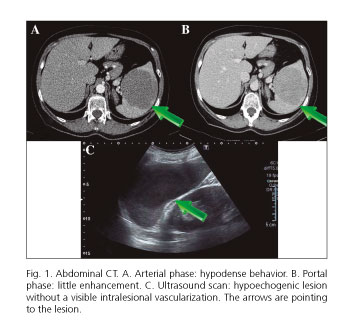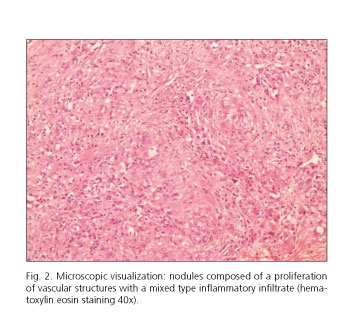Mi SciELO
Servicios Personalizados
Revista
Articulo
Indicadores
-
 Citado por SciELO
Citado por SciELO -
 Accesos
Accesos
Links relacionados
-
 Citado por Google
Citado por Google -
 Similares en
SciELO
Similares en
SciELO -
 Similares en Google
Similares en Google
Compartir
Revista Española de Enfermedades Digestivas
versión impresa ISSN 1130-0108
Rev. esp. enferm. dig. vol.109 no.3 Madrid mar. 2017
PICTURES IN DIGESTIVE PATHOLOGY
Sclerosing angiomatoid nodular transformation of the spleen. A case report
Transformación angiomatosa nodular esclerosante de bazo. Un caso clínico
Pedro Jesús Martínez-Martínez1, Ramón Solbes-Vila1, Carlos Javier Bosquet-Úbeda1 and José María Roig-Álvaro2
Departments of 1Radiology and 2Pathology. Hospital Mediterráneo. Almería, Spain
Case report
A 57 year old woman with only a history of depression presented to the gastroenterologist with clinical features of heartburn, and onemonth history of epigastric abdominal pain and left hypochondrium pain. In the physical examination no significant findings were seen, and the blood analysis was completely normal.
An abdominal ultrasound scan was conducted, where a hypoechogenic lesion was found which deformed the splenic contour without clearly seeing an intralesional vascularization. On abdominal CT, a low attenuation 9 x 6 cm injury was found that deformed the spleen contour with a hypodense behavior in arterial phase, with a little enhancement in portal phase, and which was homogenizing in late phase (Fig. 1).
A total splenectomy was performed and the macroscopic study confirmed a welldelimited lesion in the addendum splenic tissue, 9 cm long from the major axis, formed by a fleshy, reddish tissue with whitish and a sort of star shaped foci with an increased consistency. The microscopy examination revealed multiple varying diameter nodules delimited by fibrohyaline tracts, formed by small caliber vascular structures lined by prominent and typical endothelium, with an immunohistochemical profile which refers to the characteristic capillaries one (CD31+, CD34+, CD8) (Fig. 2). The SANT diagnosis was reached via a pathological study.
Discussion
SANT is a benign vascular condition which has been recently alluded to, the first case being published by Martel et al. in 2004. Therefore, the cases which have been published are very limited. It involves a proliferation of angiomatoid/vascular nodules which predominantly affect women aged 27 to 68. It is usually detected as a coincidental finding in asymptomatic patients.
The etiopathogenesis is not wellknown although it points to several causes: an association with Epstein Barr virus, an abnormal transformation in the red pulp due to a stromal proliferation, or a final stage with a range of benign splenic lesions including harmatomas or inflammatory pseudoneoplasms. In recent studies it has been connected to the typical sclerosing injuries of the disorder related to immunoglobulin G4 (IgG4).
The differential diagnosis must be established with metastases, hemangioma and littoral cell angioma, as well as lymphoproliferative syndrome, harmatoma, inflammatory pseudoneoplasm, and other lesions both benign and malignant.
The presumptive diagnosis is established by imaging tests, especially CT and MR, and the final diagnosis is well established on the basis of pathology. Splenectomy is the treatment of choice since it not only confirms diagnosis but removes the problem as it is a nonrecurrent lesion.
References
1. Burneo EM, Franco HR, Castro AY, et al. Transformación angiomatosa nodular esclerosante del bazo (SANT). Un tumor muy infrecuente. Cirugía Esp 2012;9:607-9. [ Links ]
2. Raman SP, Singhi A, Horton KM, et al. Sclerosing angiomatoid nodular transformation of the spleen (SANT): Multimodality imaging appearance of five cases with radiology-pathology correlation. Abdom Imaging 2013;38:827-34. DOI: 10.1007/s00261-012-9949-4. [ Links ]
3. Watanabe M, Shiozawa K, Ikehara T, et al. A case of sclerosing angiomatoid nodular transformation of the spleen: Correlations between contrast-enhanced ultrasonography and histopathologic findings. J Clin Ultrasound 2013;42:103-7. DOI: 10.1002/jcu.22062. [ Links ]











 texto en
texto en 



